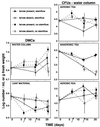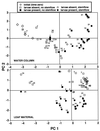Effects of larval mosquitoes (Aedes triseriatus) and stemflow on microbial community dynamics in container habitats
- PMID: 10347058
- PMCID: PMC91393
- DOI: 10.1128/AEM.65.6.2661-2673.1999
Effects of larval mosquitoes (Aedes triseriatus) and stemflow on microbial community dynamics in container habitats
Abstract
The dynamics of the microbial food sources for Aedes triseriatus larvae in microcosms were found to be strongly influenced by larval presence. The total abundance of bacteria in water samples generally increased in response to larvae, including populations of cultivable, facultatively anaerobic bacteria. Additionally, a portion of the community shifted from Pseudomonaceae to Enterobacteriaceae. Bacterial abundance on leaf material was significantly reduced in the presence of actively feeding larvae. Principle-component analysis of whole community fatty acid methyl ester (FAME) profiles showed that larvae changed the microbial community structure in both the water column and the leaf material. Cyclopropyl FAMEs, typically associated with bacteria, were reduced in microcosms containing larvae; however, other bacterial fatty acids showed no consistent response. Long-chain polyunsaturated fatty acids characteristic of microeukaryotes (protozoans and meiofauna) declined in abundance when larvae were present, indicating that larval feeding reduced the densities of these microorganisms. However, presumed fungal lipid markers either increased or were unchanged in response to larvae. Larval presence also affected microbial nitrogen metabolism through modification of the physiochemical conditions or by grazing on populations of bacteria involved in nitrification-denitrification. Stemflow primarily influenced inorganic ion and organic compound concentrations in the microcosms and had less-pronounced effects on microbial community parameters than did larval presence. Stemflow treatments diluted concentrations of all inorganic ions (chloride, sulfate, and ammonium) and organic compounds (total dissolved organic carbon, soluble carbohydrates, and total protein) measured, with the exceptions of nitrite and nitrate. Stemflow addition did not measurably affect larval biomass in the microcosms but did enhance development rates and early emergence patterns of adults.
Figures





Similar articles
-
Beetle (Coleoptera: Scirtidae) facilitation of larval mosquito growth in tree hole habitats is linked to multitrophic microbial interactions.Microb Ecol. 2011 Oct;62(3):690-703. doi: 10.1007/s00248-011-9872-1. Epub 2011 May 24. Microb Ecol. 2011. PMID: 21607876 Free PMC article.
-
Indirect effects of soluble nitrogen on growth of Ochlerotatus triseriatus larvae in container habitats.J Med Entomol. 2006 Jul;43(4):677-88. doi: 10.1603/0022-2585(2006)43[677:ieosno]2.0.co;2. J Med Entomol. 2006. PMID: 16892624
-
Bacterial and fungal biomass responses to feeding by larval Aedes triseriatus (Diptera: Culicidae).J Med Entomol. 2001 Sep;38(5):711-9. doi: 10.1603/0022-2585-38.5.711. J Med Entomol. 2001. PMID: 11580044
-
Leaf-associated bacterial and fungal taxa shifts in response to larvae of the tree hole mosquito, Ochlerotatus triseriatus.Microb Ecol. 2008 May;55(4):673-84. doi: 10.1007/s00248-007-9310-6. Microb Ecol. 2008. PMID: 17899246 Free PMC article.
-
What Can Larval Ecology Tell Us About the Success of Aedes albopictus (Diptera: Culicidae) Within the United States?J Med Entomol. 2016 Sep;53(5):1002-12. doi: 10.1093/jme/tjw046. Epub 2016 Jun 28. J Med Entomol. 2016. PMID: 27354437 Review.
Cited by
-
An acute trophic cascade among microorganisms in the tree hole ecosystem following removal of omnivorous mosquito larvae.Community Ecol. 2010 Dec;11(2):171-178. doi: 10.1556/ComEc.11.2010.2.5. Community Ecol. 2010. PMID: 25342946 Free PMC article.
-
Pollution gradients shape microbial communities associated with Ae. albopictus larval habitats in urban community gardens.FEMS Microbiol Ecol. 2024 Oct 25;100(11):fiae129. doi: 10.1093/femsec/fiae129. FEMS Microbiol Ecol. 2024. PMID: 39327012 Free PMC article.
-
Beetle (Coleoptera: Scirtidae) facilitation of larval mosquito growth in tree hole habitats is linked to multitrophic microbial interactions.Microb Ecol. 2011 Oct;62(3):690-703. doi: 10.1007/s00248-011-9872-1. Epub 2011 May 24. Microb Ecol. 2011. PMID: 21607876 Free PMC article.
-
Occurrence of sweet refuse at disposal sites: rainwater retention capacity and potential breeding opportunities for Aedes aegypti.Environ Sci Pollut Res Int. 2018 May;25(14):13833-13843. doi: 10.1007/s11356-017-1078-8. Epub 2018 Mar 6. Environ Sci Pollut Res Int. 2018. PMID: 29512008
-
Species composition of bacterial communities influences attraction of mosquitoes to experimental plant infusions.Microb Ecol. 2010 Jan;59(1):158-73. doi: 10.1007/s00248-009-9565-1. Epub 2009 Jul 30. Microb Ecol. 2010. PMID: 19641948 Free PMC article.
References
-
- Addicot J F. Predation and prey community structure: an experimental study of the effect of mosquito larvae on the protozoan communities of pitcher plants. Ecology. 1974;55:475–492.
-
- Aitchison J. The statistical analysis of compositional data. London, England: Chapman and Hall; 1986.
-
- Austin D A, Baker J H. Fate of bacteria ingested by larvae of the freshwater mayfly, Ephermera danica. Microb Ecol. 1988;15:323–332. - PubMed
-
- Balciunas D, Lawler S P. Effects of basal resources, predation, and alternative prey in microcosm food chains. Ecology. 1995;76:1327–1336.
-
- Balkwill D L, Murphy E M, Fair D M, Ringelberg D B, White D C. Microbial communities in high and low recharge environments: implications for microbial transport in the Vadose zone. Microb Ecol. 1998;35:156–171. - PubMed
Publication types
MeSH terms
Substances
Grants and funding
LinkOut - more resources
Full Text Sources

